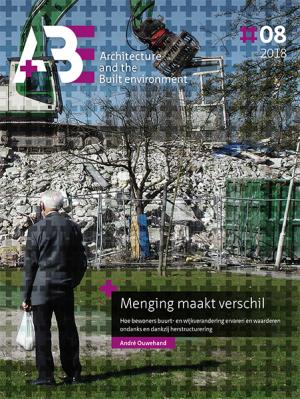Hosted by
Menging maakt verschil: Hoe bewoners buurt- en wijkverandering ervaren en waarderen ondanks en dankzij herstructurering
Synopsis
For decades, the new housing estates that were built in the Netherlands after World War II had a solid reputation as neighbourhoods of progress (Reijndorp & Van der Ven 1994). Young households were queuing up for a dwelling in these modernist urban areas, which were known for an abundance of light, air and space, though only higher-skilled and white-collar workers could afford to live there. But with growing prosperity and rising expectations for housing quality, more well-to-do households moved into new residential areas. They were replaced by low-income households who from the end of the twentieth century on were also of migrant descent. The identity and reputation of many of these early post-war areas thus changed. Often labelled problem areas, they have been characterized as concentrations of joblessness, social deprivation, ethnic minorities, conflicting lifestyles, criminality and vandalism (Klijn & Koolma 1987; Ministerie van VROM 1997; Prak & Priemus 1985).
Neighbourhoods change. This is an inevitable and iterative process and it has many facets: ageing; economic, social and spatial development; and the perception of and subsequent reactions to these changes by residents as well as institutional actors like municipalities, housing associations, private landlords and other investors (Temkin & Rohe 1996). The accumulation of problems in post-war areas prompted urban renewal policies (Priemus 2004b; 2006) and intensive urban restructuring programmes throughout the Netherlands. A preliminary case study (Ouwehand & Davis 2004) revealed a positive evaluation of the interventions to improve these post-war neighbourhoods by demolition and new housing construction, often for owner-occupancy. But it also revealed a low level of neighbourhood satisfaction, which was attributed to a clash of incompatible lifestyles due to the large influx of new residents from lower-income groups, often households from one of the ethnic minority groups. According to the incumbent residents, these newcomers did not feel a personal bond with the neighbourhood and did not conform to the prevailing standards. Residents as well as other stakeholders urged further intervention.
That sketch of the problem led me to formulate the following research question for this doctoral dissertation: How do residents with different ways of life perceive and assess their changed and changing neighbourhood?
Three issues play a key role in this research. The first is the idea of ‘social mix’, a concept that dates back to the mid-nineteenth century (Sarkissian 1976) and has been pivotal to the debate about urban restructuring ever since Wilson published The Truly Disadvantaged (1987). It has prompted an abundance of scholarly research, though with divergent outcomes (Bond et al. 2011; Sautkina et al. 2012), and a rather polarized debate (Veldboer 2010). The second issue is that neighbourhood change occurs within the context of societal, economic and social change and is heavily influenced by urban and housing policies. Early post-war areas in the Netherlands are the product of housing policies implemented during the formation of the welfare state in the 1950s and 1960s (Van der Schaar 1987; Harloe 1995). These policies changed in the course of the following decades. Whereas the Dutch social housing system is not already residualized, sequential measures (Boelhouwer & Priemus 2014; Beuzenkamp et al. 2017) have reduced the volume of affordable social housing and increased the concentration of social housing in specific parts of the city, particularly the post-war areas (Hochstenbach & Musterd 2016; Zwiers et al. 2016). The third issue is that, since the beginning of the 1980s, neighbourhood change has been connected to the influx of new residents of migrant origin. These newcomers are often referred to as allochthones, as distinguished from autochthones, or native-Dutch residents423. In the Netherlands the debate about the integration of ethnic minorities started in the early 1990s, fuelled then by populist politicians like Fortuyn (assassinated in 2002) and nowadays by the anti-Islam politician Wilders. This debate continues to dominate the policy discourse. Discriminatory housing-allocation practices were fiercely opposed in the twentieth century. A proposal for unorthodox measures to avoid liveability problems, which were expected to arise from the predicted rapid growth in the share of allochthonous residents in parts of Rotterdam, led in 2003 to the Rotterdam Act. Under this legislation, vulnerable (a euphemism for allochthonous) newcomers could be prevented from obtaining a dwelling in specified areas of Rotterdam (Ouwehand & Doff 2013a).
The main aim of the present study is to unravel the two main drivers of neighbourhood satisfaction among residents with different ways of life. The first is an autonomous process: the influx of allochthonous newcomers in the neighbourhood as a result of moving processes. The second is a policy intervention to achieve social mix by demolition and new-built housing for owner-occupancy. I have selected the district of Zuidwijk in Rotterdam, one of the cases in a preliminary study, as the location of my research. Besides all the necessary ingredients, the district also has an interesting history and was the site of previous research on neighbourhood change. Building upon that basis, in 2008 we conducted 84 interviews with 116 persons in total, spread over three neighbourhoods in the district of Zuidwijk. The first is the Velden, half of which was slated for demolition, the other half predominantly designated for the elderly and further for single-family dwellings. The second is the Kampen, featuring renovated small single-family dwellings in the social rental sector. And the third is Burgen, featuring renovated single-family social rental, new-built single-family dwellings for owner-occupiers and new-built rental housing for the elderly. All the interviews were taped and transcribed and later coded and analysed using Atlas.ti. Seeking insight in the development of Zuidwijk, we held interviews with key persons as part of the preliminary research in 2003-2004 and with key persons in the housing association Vestia prior to the fieldwork in 2008 and in later years.

